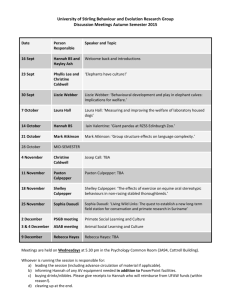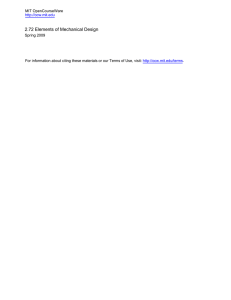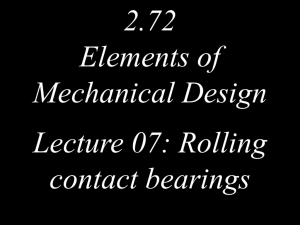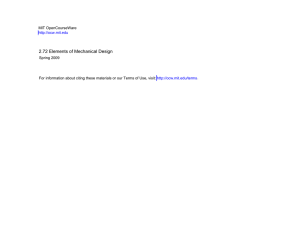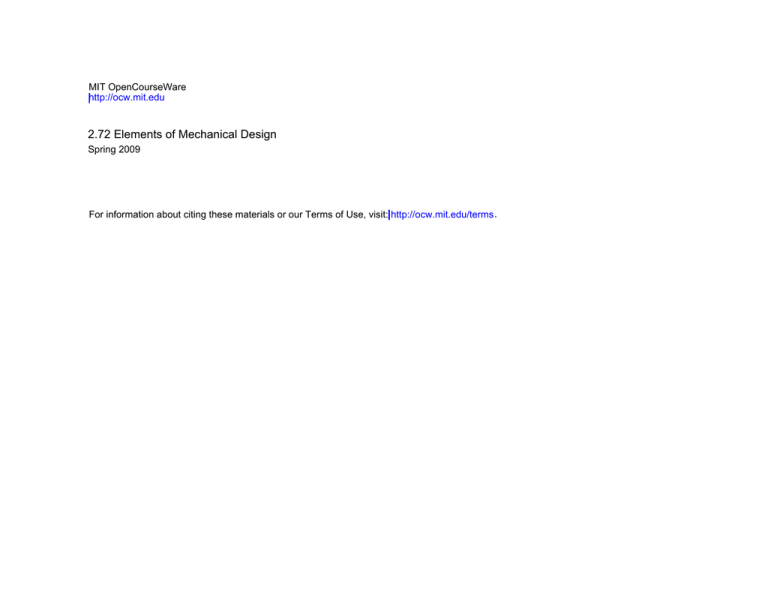
MIT OpenCourseWare
http://ocw.mit.edu
2.72 Elements of Mechanical Design
Spring 2009
For information about citing these materials or our Terms of Use, visit: http://ocw.mit.edu/terms.
Reading and plans
Shigley-Mischke sections
None
Today: Actuators: Hydraulic and Electromagnetic
Energy transfer and scale
Hydraulic / fluidic
DC Permanent magnet motors
Perhaps…. wrap up of MEMS
© Martin Culpepper, All rights reserved
1
Friction-based machines
Purpose:
Do work at a given rate, Energy - Power
Physics: Energy and mass conservation/balances
Characteristics of import
Load
Speed
Bandwidth
Cost
© Martin Culpepper, All rights reserved
2
And there can be other issues of import…
Image removed due to copyright restrictions. Please see
http://www.onefunsite.com/images/donkey.jpg
© Martin Culpepper, All rights reserved
3
Consequences
Please see trigirl. “Crane Drops Steamroller on Car!” May 8, 2007. LiveVideo. Accessed November 25, 2009.
http://www.livevideo.com/video/16A18C6512B945C29547A8658E890AF1/crane-drops-steamroller-on-car.aspx
© Martin Culpepper, All rights reserved
4
An unpleasant (I hope) example
© Martin Culpepper, All rights reserved
5
Common actuators for mechanical systems
Biological
Pneumatic/Hydraulic
Electromagnetic
Electrostatic
Piezo
Thermal
© Martin Culpepper, All rights reserved
6
Biological
People powered machines
Energy
Power
Load
Speed
Bandwidth
Why is it important to understand what humans can do?
© Martin Culpepper, All rights reserved
8
Hydraulics
Basic principles
Sub-system design
Pump
Motor
Output shaft
Τ2=?
Tp = ?
Dp = ½ in3/rev
Dm = 2 in3/rev
ωp = 100 rpm
Apiston = 1 in2
ω2 = 100 rpm
Nm = 40
vp = ?
N2 = ?
p1
Pump
p2
p3
Motor
p4
Flow direction
Reservoir
© Martin Culpepper, All rights reserved
10
Examples: Real but practical ;) ?
Image removed due to copyright restrictions. Please see
http://darkdiamond.net/wp-content/uploads/2006/08/115638952415_hugegundam1.JPG
http://gizmodo.com/
© Martin Culpepper, All rights reserved
11
Other less than practical examples
Please see HydraulicGuitar. “Hydraulic Guitar.” September 10, 2006. YouTube.
Accessed November 25, 2009. http://www.youtube.com/watch?v=Elt1XriaQXU
© Martin Culpepper, All rights reserved
12
Other less than practical examples
Please see any video of a hydraulic low rider assembly.
© Martin Culpepper, All rights reserved
13
Other less than practical examples
Please see arefadib. “The Flying Steamroller.” October 17, 2006. YouTube.
Accessed November 25, 2009. http://www.youtube.com/watch?v=sKGRRIiR5xA
© Martin Culpepper, All rights reserved
14
Hydraulic systems in machines
Advantage:
High force/torque and routing of power
Disadvantage:
Leaking and wear due to contaminants
Liquids & gases in fluid-based machinery
Hydraulics:
Pneumatics:
© Martin Culpepper, All rights reserved
Fluid is a liquid
Fluid is a gas
15
Example: Piston pump doing work
Hydraulic machines can be used to do work
Load on the system extracts energy from the liquid
Pressure increases between the input and output components
Pressure is used to do work on internal parts of hydraulic devices
Power is input/extracted via shaft (motor) or rod (cylinder)
Power out
0
Motor
© Martin Culpepper, All rights reserved
Cylinder
Pressure gauge
16
Volume flow rate and displacement
Displacement (D)
Displacement = volume of fluid moved / cycle
Cycle = rotation (drill pump) or stroke (cylinder)
Q = volume moved per unit time
D
Volume
Cycle(s)
*
f
Cycles
*
second
=
=
Q
Volume
second
F is the frequency of a machine’s cycle
o For hydraulic pumps, f = speed of the shaft = ω/(2π)
o For hydraulic motors, f = speed of the shaft = ω/(2π)
o For cylinders,
f = strokes/second
© Martin Culpepper, All rights reserved
ω [rad/s]
ω [rad/s]
f [Hertz]
17
Displacement: Physical example
D = volume pumped per cycle
1 Cycle = expansion + contraction
rinitial
r final
Vinitial
Vinitial
4
= ⋅ π ⋅ (rinitial )3
3
Vfinal =
Vfinal
Displacement = D = Vinitial − Vfinal =
© Martin Culpepper, All rights reserved
[
(
4
⋅ π ⋅ r final
3
(
)3
4
⋅ π ⋅ (rinitial )3 − r final
3
)3 ]
18
Incompressibility
Incompressible fluid:
Compressible fluid:
© Martin Culpepper, All rights reserved
19
Why is incompressibility important?
Mass balances
The mass density (ρm) of fluids changes with pressure (Δp)
Compressible fluids: exhibit large (Δρm) for small (Δp)
If (Δρm) is large, it is possible to store significant mass in a machine
This complicates our analysis
Σm in = Σm out
© Martin Culpepper, All rights reserved
d
+ mstored
dt
20
Why is incompressibility important?
Energy balances
All fluids store energy when compressed (similar to a spring)
Compressible fluids store A LOT of energy (think balloons!!)
Stored energy complicates analysis (calculating can be difficult)
ΣEin = [ΣEout ] + ΣEstored
© Martin Culpepper, All rights reserved
21
Example: “Locked” piston positions
Incompressible fluid:
Compressible fluid:
© Martin Culpepper, All rights reserved
22
Incompressibility
Bulk modulus: Measures of resistance to Δvolume
β =−
dp
⎛ dV
⎞
⎜ V
⎟
initial ⎠
⎝
For small (incremental) changes in volume :β ≈ −
Δp
⎛ ΔV
⎞
⎜
⎟
V
initial ⎠
⎝
Example: Fluid in tube exposed to pressure increase
ΔV
V final
Vinitial
© Martin Culpepper, All rights reserved
23
Incompressibility
Hydraulics, pneumatics and incompressibility
Low β, usually compressible
High β, usually incompressible
Pneumatics = gas:
Hydraulics = liquid:
What makes a good assumption?
Depends on the error you are willing to live with
Example: Incompressibility of water (e.g. H2O)
β H 2O = 2.2 ×109
N
m2
= 3.2 ×105
(ΔV V ) ≈ − Δβp
lbf
in 2
Example for H 2O where Δp = 2500 psi, ΔV
V
= −0.006 = −0.6%
Is this OK?
© Martin Culpepper, All rights reserved
24
Volume flow rate, Q
Link between mass flow rate & volume flow rate:
Q = time rate of volume flow through a hydraulic system
From mass conservation
From 8.01
Qi =
m i
ρ mi
Σm in
ρ m in
=
=
ρ mi ⋅ Ai ⋅ v i
ρ mi
Σm out
ρ mout
d
(Vstored ) ~ 0
dt
d
mstored
d
+ dt
→ Qin = Qout + (Vstored )
dt
ρ mstored
Mass densities are equal and cancel out of equation if fluid is incompressible
For incompressible flow in a pipe : Ai n ⋅ vi n = Qi n = Qout = Aout ⋅ v out
© Martin Culpepper, All rights reserved
25
Vane pumps
Series of vanes extending radially from rotating core
Vanes can slide in/out or deform depending upon design
How a sliding vane pump works:
Step 1: Fluid enters when volume between vanes is increasing
Step 2: Fluid travels when volume between vanes does not change
Step 3: Fluid exits at when volume between vanes is decreasing
Image removed due to copyright restrictions. Please see
http://pumpschool.com/images/vnsteps.gif
© Martin Culpepper, All rights reserved
credit: pumpschool.com
26
Pump types: Piston
How it works:
Step 1: Piston forces fluid out during initial stroke
Step 2: Valves change fluid path (only allows flow into pump)
Step 3: Piston recharged with fluid, cycle starts again
What is the displacement?
© Martin Culpepper, All rights reserved
27
Pump types: Piston
How it works:
Step 1: Piston forces fluid out during initial stroke
Step 2: Valves change fluid path (only allows flow into pump)
Step 3: Piston recharged with fluid, cycle starts again
Images removed due to copyright restrictions. Please see
http://www.animatedsoftware.com/pics/pumps/wobble.gif
http://www.flexicad.com/bilder/Rhino_Galerie/Kolpenpumpe.jpg
www.animatedsoftware.com/pumpglos/wobble.htm
© Martin Culpepper, All rights reserved
http://gallery.mcneel.com/fullsize/11155.jpg
28
Pump types: External gear pump
Only one gear is driven, the other spins free
Which way does the flow go?
Step 1: Fluid comes in at ?
Step 2: Fluid travels through ?
Step 3: Fluid exits at ?
What is the displacement?
© Martin Culpepper, All rights reserved
29
Pump types: External gear pump
Bushing Bearings
O-Ring
a) Pump Body
© Martin Culpepper, All rights reserved
a) Gear and Shaft
30
Hydraulics
Exercise
Competition: Pump
Form group
In 10 minutes, make best estimate of gear pump displacement
Hand in answer/analysis at end of exercise (with all names)
Sketches, calculations, etc… must be handed in before bell sounds
91
R10
10
H1
R5
H2
10
50
10
R10
13 5
32
H7
13
5
H5
R14
70
R14
H3
H4
26
10
H6
12
4
10
Gear Pump Cavity Plate with Dimensions
All Dimensions in mm
© Martin Culpepper, All rights reserved
2
10
50
28
14
R10
0
10
6
8
Minutes
32
Hydraulics
power
Power example: Pump at steady state
Tshaft
Ain
pin
Aout
Pump
xin
pout
xout
Ai n ⋅ vi n = Qi n = Qout = Aout ⋅ v out
© Martin Culpepper, All rights reserved
34
Example: Pump at steady state
Work done on
fluid via shaft input
Pressure force does work
on fluid entering pump
Tshaft
Ain
pin
Aout
Pump
vin
© Martin Culpepper, All rights reserved
Pump does work on
Fluid exiting pump
pout
v out
35
Example: Pump at steady state
ΣPin = [ΣPout ] +
d
(Estored ) → Pinlet + Pshaft = [Poutlet + Ploss ] + d (Estored )
dt
dt
Pinlet = [Fin ]⋅ vin = [ pi n ⋅ Ai n ]⋅ vin
Tshaft
Pshaft = Tshaft ⋅ ωshaft
Poutlet = [Fout ]⋅ v out = [ pout ⋅ Aout ]⋅ v out
Ain
pin
Aout
Pump
pout
If can assume A&B, Ploss & d(E)/dt can be neglected
A.
B.
d
(Estored ) <<< Pin − Pout
dt
vin
v out
Ploss <<< Pin − Pout
Substituting into energy balance (top equation on sheet)
[ pin ⋅ Ain ]⋅ vin + Tshaft ⋅ ω shaft = [ [ pout ⋅ Aout ]⋅ vout + ~ 0]+ ~ 0
© Martin Culpepper, All rights reserved
36
Power example: Pump at steady state
[ pin ⋅ Ain ]⋅ vin + Tshaft ⋅ ω shaft = [ [ pout ⋅ Aout ]⋅ vout + ~ 0]+ ~ 0
Ai n ⋅ vi n = Qi n = Qout = Aout ⋅ v out
Qi n = Qout = Q
Tshaft
[ pout − pin ]⋅ Q = Tshaft ⋅ ω shaft
Ain
pin
Pump
vin
© Martin Culpepper, All rights reserved
Aout
pout
v out
37
Hydraulics
System example
Power example: Pump at steady state
Dm = 0.5 in3/rev
3
Dp = 0.5 in /rev
Tm = ?
Tp = 10 in-lbf
ωm = ?
ωp = 1000 rpm
2π
p1
p2
Pump
p1 = 10 psi
p3
Motor
p2 = ? psi
p3 = 10 psi
Density = ρ
Reservoir
© Martin Culpepper, All rights reserved
39
DC permanent
magnet motors
DC Permanent magnet motor
T vs. ω for Black & Decker Screw Driver
4.0
T [N-m] = - 0.012 [N-m/rpm] * ω + 3.678 [N-m]
Torque [N-m]
3.0
2.0
1.0
0.0
0
50
100
150
200
250
300
350
ω [ rpm ]
© Martin Culpepper, All rights reserved
⎡
ω ⎤
T(ω ) = TStall ⎢1 −
⎥
ω
NL ⎦
⎣
ω
rpm
Data
310
210
190
167
148
121
67
33
0
T
Nm
Data
0.00
0.90
1.08
1.47
2.04
2.30
2.92
3.32
3.60
T
Nm
Fitted
-0.09
1.11
1.34
1.63
1.85
2.17
2.83
3.23
3.63
% Error
N/A
23
24
10
-9
-6
-3
-3
1
41
Understanding the model
y
Simple 1 loop model
x
z
2
B
T, ω
r
FE
1
r
V1
V4
Low loss in wires
Steady state
Single loop
No ferrous cores
Snap shot with loop plan in
the y-z plane
3
FB
i
Assumptions
FB
Goal: understand trends
FE
L
4
© Martin Culpepper, All rights reserved
42
Point we will study
Points we are studying
D
+TMAX
A
T=0
D
A
B
C
C
D
-TMAX
B
Torque curve of simple loop
© Martin Culpepper, All rights reserved
Side view of simple loop
43
Forces
y
Force on wire
x
z
2
B
T, ω
r
L points in direction of current flow
L
FE
MAGNETIC FLUX DENSITY, B
FB
1
r
V1
CONDUCTOR / WIRE
CURRENT, iwire
3
FB
i
V4
K
K K
FB = i ⋅ (L × B )
FE
4
© Martin Culpepper, All rights reserved
MAGNETIC FORCE
Lorentz Force
L
K
K
K K
FE = q ⋅ E + q ⋅ v × B
44
Torque inducing forces on wire
y
Force on wire
x
z
2
B
T, ω
r
FB
1
r
V1
V4
© Martin Culpepper, All rights reserved
K
K K
T = 2 ⋅ (r × FB )
90o in
y-z plane
T = 2 ⋅ r ⋅ (i ⋅ L ⋅ B ⋅) ⋅ sin (θ r − F )
T = 2⋅r ⋅
L
4
Torque at ω = 0
3
FB
i
K
K K
FB = i ⋅ (L × B )
(V1 − V4 ) Battery
(V1 − V4 ) Battery
R
⋅L⋅B
T ⋅R
=
2⋅r ⋅ L⋅ B
45
dV
E=−
dx
Lorentz force
y
Force
K dueK to E & B K
K
FE = q ⋅ E + q ⋅ (v × B )
T, ω E = v ⋅ B ⋅ sin (θ v − B )
x
z
2
B
r
FE
1
r
V1
3
i
V4
FE
4
© Martin Culpepper, All rights reserved
Wire 1-2
(V2 − V1 ) ω
L
= (r ⋅ ω ) ⋅ B
Wire 2-3
K K
v × B not along r
V2 ω = V3 ω
Wire 3-4
L
(V4 − V3 ) ω
L
= (r ⋅ ω ) ⋅ B
46
Induced voltage due to rotation
y
ΔV due to rotation, ω
x
z
2
B
T, ω
(V2 − V1 ) ω
L
r
FE
1
r
(V4 − V3 ) ω
L
= (r ⋅ ω ) ⋅ B
V2 ω = V3 ω
= (r ⋅ ω ) ⋅ B
V1
3
i
V4
FE
4
© Martin Culpepper, All rights reserved
(V4 − V1 ) ω
L
L
= 2 ⋅ (r ⋅ ω ) ⋅ B
(V1 − V4 ) ω = −2 ⋅ (r ⋅ ω ) ⋅ B ⋅ L
47
Total voltage
y
ΔV due to rotation, ω
x
z
2
B
T, ω
r
FE
FB
1
r
V1
3
FB
i
V4
(V1 − V4 ) ω = −2 ⋅ (r ⋅ ω ) ⋅ B ⋅ L
ΔV due to battery
Total potential diff.
(V1 − V4 ) Battery
T ⋅R
=
2⋅r ⋅ L⋅ B
ΔV = (V1 − V4 ) Battery + (V1 − V4 ) ω
FE
4
© Martin Culpepper, All rights reserved
L
T ⋅R
ΔV =
− 2 ⋅ (r ⋅ ω ) ⋅ B ⋅ L
2⋅r ⋅ L⋅ B
48
Torque – ω relationship
y
Total potential diff.
x
z
2
B
T, ω
r
FE
r
V1
3
FB
i
V4
FE
4
© Martin Culpepper, All rights reserved
Ohm’s law
ΔV = i ⋅ R
FB
1
T ⋅R
ΔV =
− 2 ⋅ (r ⋅ ω ) ⋅ B ⋅ L
2⋅r ⋅ L⋅ B
Total potential diff.
i⋅R =
T ⋅R
− 2 ⋅ (r ⋅ ω ) ⋅ B ⋅ L
2⋅r ⋅ L⋅ B
T- ω relationship
L
4 ⋅ r 2 ⋅ L2 ⋅ B 2
T = 2⋅i ⋅ L ⋅ r ⋅ B −
ω
R
49
Torque – ω relationship cont.
y
T- ω relationship
x
z
2
B
T,
r
FE
r
V1
V4
T- ω relationship
3
FB
i
Stall torque
TStall = 2 ⋅ i ⋅ L ⋅ r ⋅ B
FB
1
4 ⋅ r 2 ⋅ L2 ⋅ B 2
T = 2⋅i ⋅ L ⋅ r ⋅ B −
ω
R
ω
T = TStall
FE
4 ⋅ r 2 ⋅ L2 ⋅ B 2
−
ω
R
L
4
© Martin Culpepper, All rights reserved
50
Torque – ω relationship cont.
y
T- ω relationship
x
z
2
B
T, ω
r
FE
FB
1
Motor
constant
T vs. ω for Black & Decker Screw Driver
4.0
3
i
FE
4
© Martin Culpepper, All rights reserved
Tstall
L
T [N-m] = - 0.012 [N-m/rpm] * ω + 3.678 [N-m]
T = TStall −
3.0
Torque [N-m]
FB
Loop
constant
T- ω curve
r
V1
V4
T = TStall
4 ⋅ r 2 ⋅ L2 ⋅ B 2
−
ω
R
TStall
ω NL
ω
2.0
1.0
ωNL
0.0
0
50
100
150
200
ω [ rpm ]
250
300
350
51
Scaling
Follow up on
micro-actuator lecture
Electrostatics
How does electrostatic physics scale?
UE =
ε o ⋅ L ⋅ L ⋅V
2
2⋅ z
How does ratio of FElectric scale to FBody?
FElectric 1
~
FBody
L
What does this mean for MuSS interaction?
What happens if you downsize each by factor of 10?
© Martin Culpepper, All rights reserved
53
Electrostatics
U Electric − z =
ε o ⋅ L ⋅ L ⋅V
2
2⋅ z
FElectric − z
dU
=−
dz
Fbody = ρ ⋅ V
FElectric − z =
3
ε o ⋅ L2 ⋅V 2
2⋅ z2
FElectric 1
~
FBody
L
Table removed due to copyright restrictions. Please see
http://www.sizes.com/built/clean_rooms.htm
© Martin Culpepper, All rights reserved
54
Semi-intuitive example
Cooling…
Heating…
© Martin Culpepper, All rights reserved
55
Thermal behavior
How does thermal physics scale (small Bi #)?
e
⎡ ⎛ h⋅ A ⎞ ⎤
⎟⎟⋅t ⎥
⎢ −⎜⎜
⎣ ⎝ ρ ⋅V ⋅c ⎠ ⎦
θ
T − Tinf
=
=
θ inf Tinitial − Tinf
© Martin Culpepper, All rights reserved
h ⋅ L Convection
Bi =
~
k
Conduction
56
Thermal behavior
How does thermal physics scale?
dT
− h ⋅ A ⋅ (T − Tinf ) = ρ ⋅ c ⋅ V ⋅
dt
e
⎡ ⎛ h⋅ A ⎞ ⎤
⎟⎟⋅t ⎥
⎢ −⎜⎜
⎣ ⎝ ρ ⋅V ⋅c ⎠ ⎦
τ~
h⋅L
Bi =
k
θ
T − Tinf
=
=
θ inf Tinitial − Tinf
ρ ⋅V ⋅ c
h⋅ A
→L
Is this a good or a bad thing for MEMS actuators?
For the STM?
© Martin Culpepper, All rights reserved
57
Fluidics
How do fluid-based physical phenomena scale?
π ⋅ r 4 ⋅ Δp
Q=
8⋅ μ ⋅ L
Q = U ⋅π ⋅ r 2
D
L
8 ⋅ μ ⋅U
Δp = −
⋅L
2
r
High pressure change over narrow flow paths…
© Martin Culpepper, All rights reserved
58
Fluidics
Reynolds number
D
L
Re =
ρ ⋅U ⋅ D
μ
D = 50 μm
Ratio of inertial forces to viscous forces
U = 500 μm/s
L = 1000 μm
ReAir and ReH2O << 1
What does this mean:
Heavily damped
Limits response time (ms vs. μs)
© Martin Culpepper, All rights reserved
59

